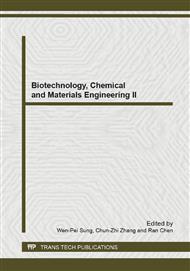p.562
p.566
p.570
p.574
p.578
p.583
p.591
p.597
p.606
Potential Species and Character of Wild Diesel Plant in Tianjin
Abstract:
In order to reveal the potentials of unknown and lessknown herbaceous wild plant (potential diesel plant) from saline-alkali wasteland for development biodiesel production, seed and plant samples from 33 species were collected and plant oil content, seed oil content, seed yield per plants and saline-alkali tolerance of the plants were analyzed. The result show that oil content in plants ranged from 1.31-15.01%. Euphorbia heyneana (15.01%) had the highest oil content followed by Ricinus communis (13.9%), Cirsium setosum (12.5%), Euphorbia nutans (11.02%), Cirsiu japonicum (9.27%). About fifty percent species were found have more seed oil content within the range of 21 to 48.5%. Maximum of 48.5% was observed in one wild species of Ricinus communis followed by Euphorbia esula (34.2%), Euphorbia nutans (29.3%), Xanthium sibiricum (28.5%), Euphorbia humifusa (28.1%), Euphorbia heyneana (24.1%), Capsella bursa-pastoris (24%), Suaeda glauca (23.6%), Artemisia argyi (23.5%), Lepidium apetalum (23%). Highest level of seed field per plant was observed in Ricinus communis, Glycine soja and the higher level of seed field was in Humulus scandens, Sonchus oleraceus, Gynura crepidioides, Artemisia argyi, Abutilon theophrasti, Cirsiu japonicum, Inula japonica, Comnyza canadensis. 14 species grew in moderate saline-alkali soil and only one species (Suaeda glauca) was in severe saline-alkali soil. Comprehensive analysis show that most potential herbaceous diesel plants are Ricinus communis, Euphorbia esula, Glycine soja, Gynura crepidioides, Cirsiu japonicum and Artemisia argyi, based on 4 values of oil content in plants, and seed, seed yield per plants and saline-alkali tolerance.
Info:
Periodical:
Pages:
578-582
Citation:
Online since:
January 2013
Authors:
Keywords:
Price:
Сopyright:
© 2013 Trans Tech Publications Ltd. All Rights Reserved
Share:
Citation:


